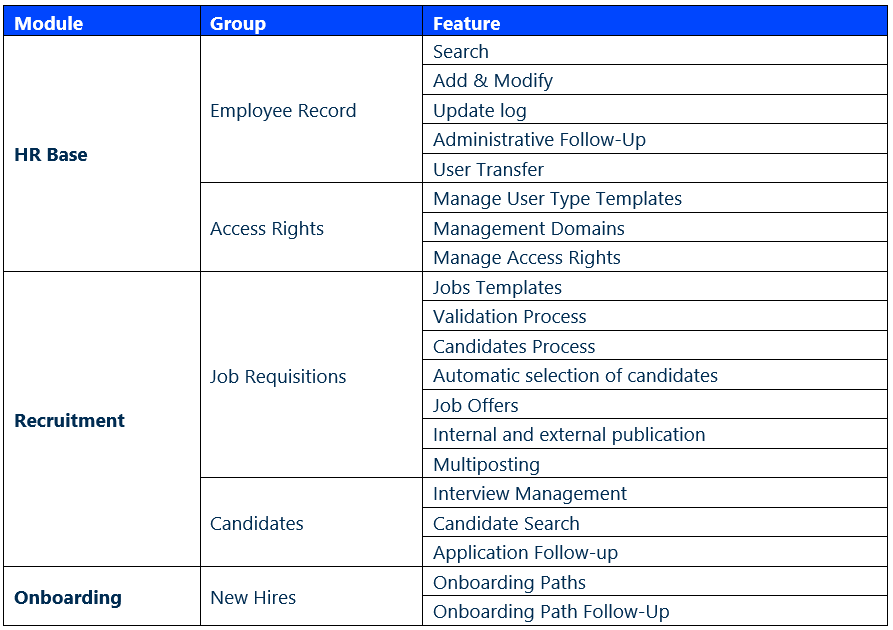
Finding the right talent management system can seem a herculean task

Finding the right talent management system can seem a herculean task. In large organizations, especially in the public sector, that means navigating a noisy software marketplace to find a solution with the scope, modularity, and intuitive processes necessary for meaningful talent management. The request for proposal (RFP) process can cut through that noise, but the RFP itself is a skillset that modern HR directors and people managers need to master.
This complete guide will walk you through how to elaborate a complete RFP for a Talent Acquisition System. We have also included the top 60 questions to ask, top features to look out for, ready to use templates to use on your demo script, and a step by step checklist on tasks to complete.
Let’s dig in!
What is an RFP?
A request for proposal (if done right) is your key to finding the best value for your budget.
In an RFP you can expect to:
Why do organizations in the public and private sector recur to RFPs?
Issuing an RFP allows your organization to compare vendors and to obtain insights into what their competitive differentiators are. While many organizations have preferred choices before jumping into an RFP, many organizations have found that issuing an RFP has given them visibility on other vendors that had better bids than others. In other words: RFPs are a way to standardize information from vendors so buyers like you , can compare apple to apple and make the best choice vs. the specific needs of their organization. Not only is it a fair process to provide an equal opportunity to different vendors to bid in your project, but, while you are at it, the learning opportunity is gold which ultimately influences you into making a more educated decision.
PRO TIP: You can launch an RFI “Request for Information” prior to launching an RFP, and this will allow you to have high level and one on one visibility on what you are looking for. Avoid simply asking for RFQ’S “Request for Quotes” as pricing can vary based on your specific needs. “Ballpark pricing” may change completely after a vendor understands your absolute needs.
What are the steps towards building a successful RFP for Talent Acquisition?
1. Prepare
This is the most crucial step. An RFP can’t assume that the vendor partner understands your organization. Before you start writing the request, you need to collect all the necessary raw material relevant to your organization’s existing talent management system as well as your HR and IT infrastructure.
If you want more background as you develop your RFP, you can send out a request for information or RFI which takes less work and states that you want a better education on the solutions available on the software market.
Cegid provides a worksheet of jobs to do and raw materials to collect prior to drafting. You can access it here.
2. Launch
Once the drafting process begins, there are several tricks you can employ to attract the best vendor partners. You should lay out what you need in the clearest terms. Set a page limit for the proposal so you’re not inundated with data you can’t sift through. Cegid looks for question grids in RFPs, an excel-based question grid is the clearest way to explain to a prospective vendor all the features your organization needs, it allows us to ask appropriate follow-ups leveraging our own deep experience building these solutions for other organizations.
2.1 What questions to ask?
Remember: Your ATS solution is directed to two audiences.
The recruiter: who will be looking for a place to manage candidate pools, CVs, job offers, and interview planning. What’s more, they’ll want to keep a record of their opinion on successful candidates and facilitate interactions with them.
The candidate: The candidate will want to simply and quickly access offers that are relevant to them at any given time and from any device. They’ll also want to easily submit their application and monitor its status in real time.
Understand that in an Applicant Tracking System there are usually 3 modules that are integrated and that there are specific features highlighted that are crucial to your benefit:

Now that it’s time to formulate your questions, know that the answers you will receive will only be as good as the questions you ask.
Click here to download a full list of 60 top ATS questions and functionalities to include in your RFP.
A successful vendor should be able to respond to all 60 questions with full functionality.
Here’s a few questions that are key differentiators:
2.2. Understand what happens on the vendor side of the process
Large organizations will sometimes give three-month windows from the launch of their RFP, not including the month or so it might take them to decide on a vendor. The logistics of a system rollout are such that such a timeline isn’t feasible.
2.3 Request a Demo!
After evaluating your vendors and shortlisting them based on their proposals, you want to move to the next step and gather all the stakeholders who will have to work with the solution to witness a live demonstration.
A demo request is essentially a preview of the software solution before you purchase. Demonstrations of this nature can be done via video conference or in person and will help you and your team understand and validate if the offer is a good fit for your needs. Demonstrations can last anywhere between 45 minutes to hours depending on the number of modules you are requesting to see.
We strongly recommend you to go for a scripted demo which requires you to provide a script or flow of your needs and expectations for the vendor to follow during their presentation. Click here to see what a DEMO script looks like for an ATS. Leverage this time to guide your vendor to present you exactly what you are looking for, ask questions and dive deep!
3. Select
The process now falls back to you. The strength of your RFP brought back a raft of proposals from top vendors. Beyond the bottom line, you should start by looking at how the vendors have answered your question grid. Cegid deals with many RFP requests and has built an extensive database of questions to which we respond to in a personalized way leveraging our expertise in each industry, allowing for a tailored and unique and in-depth solution for your organization.
Our platform, too, incorporates multifunctionality. While your current RFP might only be for an ATS, down the road you might need a performance management or succession planning system. Those can be built out in the longer term without needing to tear down the existing system. Click here to download the Selection Criteria Worksheet to support you in your selection process.
When you make the final decision of who to take on and offer a contract, look out for how the vendor might be able to take you past your immediate need and into the future, the training, the deployment time, and the price. Selecting your vendor last choices involves gathering all the information from initial business objectives and technical requirements to your last demo notes.
Once you select your vendor, don’t forget to brief the ones that didn’t make the cut. It is best practice to inform them after you announce a winner, especially after all the time they have dedicated to your RFP.
Conclusion: It’s a two-way street
The RFP is one of the first lines of dialogue in a long conversation between vendors and buyers. Building it successfully can result in a long-lasting partnership. You’re not alone in building it, though. Talk to one of Cegid’s RFP experts today.
About Cegid
Cegid is the number 1 French SaaS provider with over 4 million users worldwide. The Cegid’s Talent Management offering supports processes for talent acquisition, performance, learning and development, career and succession and compensation management either as individual point solutions or combined in fully integrated mobile and cloud-based solutions.